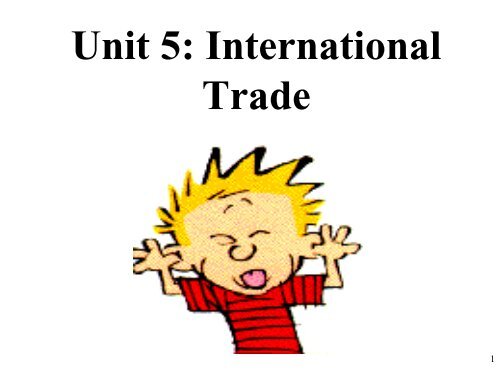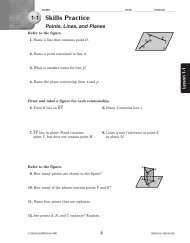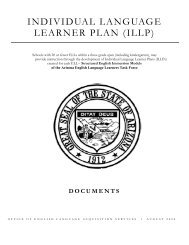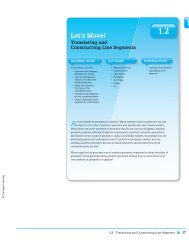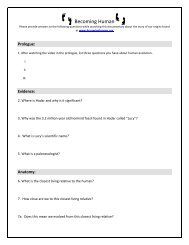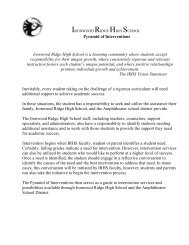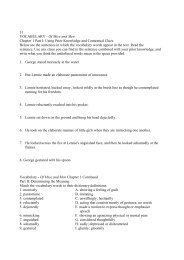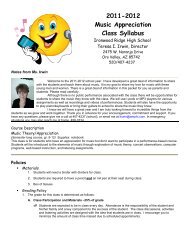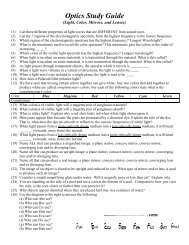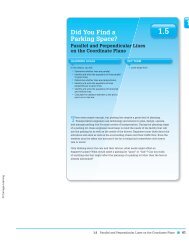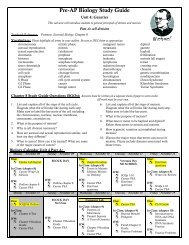AP Macro Unit 5 Summary
AP Macro Unit 5 Summary
AP Macro Unit 5 Summary
- No tags were found...
Create successful ePaper yourself
Turn your PDF publications into a flip-book with our unique Google optimized e-Paper software.
<strong>Unit</strong> 5: InternationalTrade1
International TradeWhy do people trade?2
“Magic of Markets”Brown Bag Activity3
Why do people trade?1. Assume people didn’t trade. What things wouldyou have to go without?Everything you don’t produce yourself!(Clothes, car, cell phone, bananas, heath care, etc)The Point: Everyone specializes in the productionof goods and services and trades it to others2. What would life be like if cities couldn’t tradewith cities or states couldn’t trade with states?Limiting trade would reduce people’s choices andmakes the worse off.The Point: More access to trade means morechoices and a higher standard of living.4
Absolute and ComparativeAdvantage5
Per <strong>Unit</strong> Opportunity Cost ReviewPer <strong>Unit</strong> Opportunity Cost= Opportunity Cost<strong>Unit</strong>s GainedAssume it costs you $50 to produce 5 t-shirts. What isyour PER UNIT cost for each shirt?$10 per shirtNow, take money our of the equation. Instead ofproducing 5 shirts you could have made 10 hats.1. What is your PER UNIT OPPORTUNITY COST foreach shirt in terms of hats given up?1 shirt costs 2 hats2. What is your PER UNIT OPPORTUNITY COST foreach hat in terms of shirts given up?1 hat costs a half of a shirt 6
Per <strong>Unit</strong> Opportunity Cost ReviewRonald McDonald can produce 20 pizzas or 200 burgersPapa John can produce 100 pizzas or 200 burgers1. What is Ronald’s opportunity cost for one pizza interms of burgers given up? 1 pizza cost 10 burgers2. What is Ronald’s opportunity cost for one burger interms of pizza given up? 1 burger costs 1/10 pizza3. What is Papa John’s opportunity cost for one pizza interms of burgers given up? 1 pizza costs 2 burgers4. What is Papa John’s opportunity cost for one burgerin terms of pizza given up? 1 burger costs 1/2 pizzaRonald has a COMPARATIVE ADVANTGE in theproduction of burgersPapa John has a COMPARATIVE ADVANTAGE in theproduction of pizza7
Benefits of Specializeand Trade9
Sugar (tons)Sugar (tons)S W0 301.5 293 284.5 276 267.5 259 2410.5 2312 2213.5 2115 2016.5 1918 1819.5 17454035302520151050International TradeTrade: 1 Wheat for 1.5 SugarUSAThe US Specializes andmakes ONLY Wheat5 10 15 20 25 30 5 10 15 20Wheat (tons)Wheat (tons)302520151050BrazilBrazil MakesONLY SugarS W20 018.5 117 215.5 314 412.5 511 69.5 78 86.5 95 103.5 1110
Sugar (tons)Sugar (tons)TRADE SHIFTS THE PPC!4540International TradeUSABrazil35AFTER TRADE3030252015105252015105AFTER TRADE005 10 15 20 25 30 5 10 15 20Wheat (tons)Wheat (tons)11
Sugar (tons)Sugar (tons)WheatSugarUSABrazil454030 3010 20352. Which country should EXPORT 30 Wheat?303. Which country should IMPORT 25 Wheat?252020151510(1W costs 1S) (1S costs 1W)(1W costs 2S) (1S costs 1/2W)Which country has a comparative advantage in wheat?1. Which country should EXPORT Sugar?5 10 15 20 25 30 5 10 15 20Wheat (tons)Wheat (tons)12
Output Questions:OOO=Output: Other goes Over13
Input Questions:IOU=Input: Other goes Under14
Term of Trade15
PineapplesRadiosKenyaIndia30 10(1P costs 1/3R) (1R costs 3 P)40 40(1P costs 1R) (1R costs 1P)Kenya wants RadiosIf the terms of trade for 1 radio is greater than 3pineapples then Kenya is worse off and shouldmake radios on their own.India wants PineapplesIf the terms of trade for 1 radio is less than 1pineapple then India is worse off and should makepineapples on their own.What terms of trade benefit both countries?
PineapplesRadiosKenyaIndia30 10(1P costs 1/3R) (1R costs 3 P)40 40(1P costs 1R) (1R costs 1P)Trading 1 radio for 2 pineapples will benefit bothIf Kenya produces radios by themselves, they giveup 3 Pineapples for each radio. If they can trade 2pineapples for each radio they are better off.If India produces pineapples by themselves, theygive up 1 pineapple for one radio. If they can get 2pineapples for one radio they are better off.The countries trade at a lower opportunity costthan if they made the products themselves!
Comparative Advantage PracticeCreate a chart for each of the following problems.•First- Identify if it is a output or input question•Second-Identify who has the ABSOLUTE ADVANTAGE•Third-Identify who has a COMPARATIVE ADVANTAGE•Fourth- Identify how they should specialize1. Sara gives 2 haircuts or 1 perm and hour. Megan gives 3 haircutsor 2 perms per hour.2. Justin fixes 16 flats or 8 brakes per day. Tim fixes 14 flats or 8brakes per day.3. Hannah takes 30 minutes to wash dishes and 1 hour to vacuumthe house. Kevin takes 15 minutes to wash dishes and 45 minutes tovacuum.4. Americans produce 50 computers or 50 TVs per hour. Chineseproduce 30 computers or 40 TVs per hour.18
International Trade andFinance19
Closed vs. Open EconomiesA closed economy focuses only on thedomestic price and the open economytrades for the lower world price.Export Goods & Services 16% of AmericanGDP.US Exports have doubled as a percent of GDPsince 1975.20
Balance of Trade vs.Balance of Payments
Balance of TradeNet Exports (X N ) = Exports – ImportsTrade Surplus = Exporting more than is importedTrade Deficit (aka. trade gap) = Exporting less thanis imported
Balance of Trade
Balance of Payments (BOP)Balance of trade includes only goods and servicebut balance of payments considers ALLinternational transactions.•The balance of payments is a broadermeasure of international trade.Details:The BOP summary is within a given yearPrepared in the domestic country’s currencyEx. If accounting the BOP of the U.S. it would be inthe Dollar.The balance of payments is made up of twoaccounts. The current account and the capitalaccount.
Which countries have the highest accountsurpluses and account deficits?
Current AccountThe Current Account is made up of three parts:1. Trades in Goods and Services (Net Exports)-Difference between a nation’s exports of goodsand services and its imports of goods andservicesEx: Toys imported from China, US cars exported toMexico2. Investment Income- income from the factors ofproductions including payments made toforeign investors.Ex: Money earned by Japanese car producers in the US3. Net Transfers- Money flows from the private orpublic sectorsEx: donations, aids and grants, official assistance
Capital (Financial) AccountThe Capital Account measures the purchase andsale of financial assets abroad.Purchases of things that stay in the foreign country.Examples:– US company buys a hotel in Russia– A Korean company sells a factory in Ohio– Dividends earned by Chinese citizens in the NewYork Stock Exchange (NYSE)– Australian company owns local Mall
Current or Capital Account?Identify if the examples are counted in the current orcapital account and determine if it is a credit or debitfor the US.1. Bill, an American, invests $20 million in a ski resort inCanada2. A Korean company sells vests to the US Military3. A US company, Boeing, sells twenty 747s to France4. A Chinese company buys a shopping mall in San Diego5. An illegal immigrant sends a portion of his earning tohis family6. An German investor buys $50,000 US Treasury Bonds7. Italian tourists spend 5 million in the US whileAmerican tourists spend 8 million in Italy.
Current or Capital Account?Identify if the examples are counted in the current orcapital account and determine if it is a credit or debitfor the US.1. Capital Account (financial asset), Debit2. Current Account (trade of goods/services),Debit3. Current Account (trade of goods/services),Credit4. Capital Account (financial asset), Credit5. Current Account (net transfer), Debit6. Capital Account (financial asset), Credit7. Current Account (net transfer), Debit
Practice1. U.S. income increases relative to other countries. Doesthe balance of payments move toward a deficit or asurplus?- Imports are cheaper- Americans import more- Net exports (X n ) decrease- The current account balance decreases and movestoward a deficit.2. If the U.S. dollar depreciates relative to othercountries does the balance of payments move toward adeficit or a surplus?- US exports are desirable- America exports more- Net exports (X n ) increase- The current account balance decreases and movestoward a surplus.
Foreign Exchange(aka. FOREX)Exchange Rate = Relative Price of Currencies
Video: Down and Out Dollar
Exports and Imports1. US sells cars to Mexico2. Mexico buys tractors from Canada3. Canada sells syrup t the U.S.4. Japan buys Fireworks from MexicoFor all these transactions, there aredifferent national currencies.Each country must be paid in their owncurrencyThe buyer (importer) must exchange theircurrency for that of the sellers(exporter).
The turnover in FOREX markets isalmost $4 trillion (USD) a dayCurrency CodesUSD = US DollarEUR = EuroJPY = Japanese YenGBP = British PoundCHF = Swiss FrancCAD = Canadian DollarAUD = Australian DollarNZD = New Zealand Dollar
Exchange RatesIn the FOREX market we only look at twocountries/currencies at a timeEx: US Dollars and British PoundsWe examine the price of one currency interms of the other currency. Ex:$2 = £1The Exchange Rate depends on whichcurrency you are converting.The price of one US Dollar in terms of Pounds is1 Dollar = £1/$2 = £.5The price of one Pound in terms of Dollars is1 Pound = $2/£1 = $2
What happens if you need more dollar tobuy one pound (the price for a poundincreases)?Ex: From $2=£1 to $5=£1•The U.S. Dollar DEPRECIATES relativeto the Pound.Depreciation•The loss of value of a country's currencywith respect to a foreign currency•More units of dollars are needed to buy asingle unit of the other currency.•The dollar is said to be “Weaker”
What happens if you need less dollar to buyone pound (the price for a pounddecreases)?Ex: From $2=£1 to $1=£4•The U.S. Dollar <strong>AP</strong>PRECIATES relative tothe Pound.Appreciation•The increase of value of a country'scurrency with respect to a foreign currency•Less units of dollars are needed to buy asingle unit of the other currency.•The dollar is said to be “Stronger”
S&D for the US DollarsPrice of USDollarsPound£Dollar$Equilibrium:$1 = £1Supply byAmericans2£/1$1£/1$US DollarappreciatesUS Dollardepreciates1£/4$Demandby BritishQuantity of US DollarsQ
FOREX Supply and DemandSimplifiedImagine a huge table with all the differentcurrencies from every countryThis is the Foreign Exchange Market!Just like at a product market, you can’t takethings without paying.If you demand one currency, you must supplyyour currency.Ex: If Canadians what Russian Rubles.The demand for Rubles in the FOREXmarket will increase and the supply ofCanadian Dollars will increase.
FOREX ShiftersLet’s use the example of the USDollar and the British Pound
1. Changes in Tastes-Ex: British tourists flock to the U.S…Demand for U.S. dollars increases (shifts right)Supply of British pounds increases (shifts right)Pound-depreciatesDollar-appreciates2. Changes in Relative Incomes (Resultingin more imports)-Ex: US growth increase US incomes….U.S. buys more imports…U.S. Demand for pounds increasesSupply of U.S. dollars increasesPound- appreciatesDollar- depreciates
3. Changes in Relative Price Level(Resulting in more imports)-Ex: US prices increase relative to Britain….U.S. demand for cheaper imports increases…U.S. demand for pounds increasesSupply of U.S. dollars increasesPound- appreciatesDollar- depreciates4. Changes in relative InterestRates-Ex: US has a higher interest rate than Britain.British people want to invest in USCapital Flow increase towards the USBritish demand for U.S. dollars increases…British supply more poundsPound-depreciates
PracticeFor each of the following examples, identify what willhappen to the value of US Dollars and Japanese Yen.1. American tourists increase visits to Japan.2. The US government significantly decreasespersonal income tax.3. Inflation in the Japan rises significantly fasterthan in the US.4. Japan has a large budget deficit that increasesJapanese interest rates.5. Japan places high tariffs on all US imports.6. The US suffers a larger recession.7. The US Federal Reserve sells bonds at highinterest rates.How do these scenarios affect exports and imports?
PracticeFor each of the following examples, identify what willhappen to the value of US Dollars and Japanese Yen.1. USD depreciates and Yen appreciates2. USD depreciates and Yen appreciates3. USD appreciates and Yen depreciates4. USD depreciates and Yen appreciates5. USD depreciates (Demand Falls) and Yenappreciates (Supply Falls)6. USD appreciates (Supply Falls) and Yendepreciates (Demand Falls)7. USD appreciates and Yen depreciatesScenarios 1, 2, and 4 will increase US exports becauseUS products are now relatively “cheaper”


